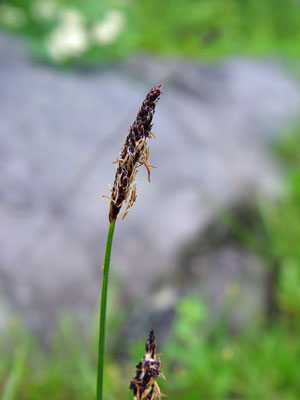DACF Home → Bureaus & Programs → Maine Natural Areas Program → Communities, Plants, and Animals → Rare Plants → Carex scirpoidea

Carex scirpoidea Michx.
Bulrush Sedge
- State Rank: S2
- Global Rank: G5
- State Status: Special Concern
Habitat: Turfy, peaty or rocky situations and alpine areas. [Rocky summits and outcrops (non-forested, upland); Non-tidal rivershore (non-forested, seasonally wet)]
Range: Greenland to Alaska, south to higher mountains of northern New England, Lake Huron, Colorado, British Columbia; also in Eurasia.
Aids to Identification: Members of this genus can be difficult to identify without careful examination of microscopic features and knowledge of general groups of species. Carex scirpoidea, in the section Scirpinae, is an erect sedge with flat, green leaves shorter than the culms. It is dioecious (seeds and pollen borne on separate plants), usually with a solitary spike. The staminate spikes are broad while the pistillate spikes are densely cylindrical with numerous hairy perigynia. The scales are dark purple-brown with a narrow green mid vein, ciliate, shorter and narrower than the perigynia.
Ecological characteristics: In Alaska, Carex scirpoidea is common in heaths and wet meadows in the mountains to at least 2000 m. Where it grows in northern New England also is in damp subalpine sites, subalpine cliffs, and northern rivershores. It has been found in a boreal circumneutral cliff community and in a circumneutral riverside seep community.
Phenology: Flowers June - August.
Family: Cyperaceae
Synonyms: Represented in Maine and New England by ssp. scirpoidea. Synonyms include Carex scirpiformis Mackenzie.
Known Distribution in Maine: This rare plant has been documented from a total of 11 town(s) in the following county(ies): Aroostook, Franklin, Piscataquis, Somerset.
Reason(s) for rarity: An arctic species, reaching its extreme southern range limit on mountains of New England.
Conservation considerations: Appears to be persisting, and subject to little threat from humans, in the few locations where it is known.